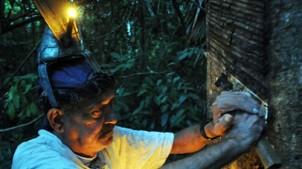
By Stefania Barca.
Stefania Barca is a Senior Researcher at the Center for Social Studies at the University of Coimbra. She’s of Italian origin and a well-known historian of water appropriation by industry in 19th century Mezzogiorno. Her latest article deals with the many ways in which labor unions and grassroots environmentalists work together to confront the same root cause of their common problems: the neoliberal economy. Source: Roar Magazine
The conflict between labor and the environment is a neoliberal construct. What we need is a broad coalition that can fundamentally transform production.
Nowadays it sounds so familiar, almost natural: the mutually exclusive demands and apparently opposing agendas of labor and the environmentalist movement. But in fact, this artificial division is nothing more than a crucial neoliberal strategy to divide two of the most powerful social movements of the industrial era, whose alliance could be a dangerous liaison with the capacity to call into question the very essence of the capitalist “treadmill of production.” It is thus essential that labor and environmental/public health organizations gain a historical perspective on their current state of conflict and become aware of the revolutionary potential of a common political project.
One place where this fact has become much clearer in recent years is the Italian city of Taranto, Apulia, where a number of citizens’ organizations and “committees” emerged in response to one of the most serious occupational, environmental and public health crises of the last decade. These organizations and committees have now begun mobilizing different resources and forms of action — from cyber-activism and film-making to street demonstrations and campaigning — to fight against the occupational blackmail of a local employer. At the last May Day celebrations, they managed to gather more than 100,000 people for a self-organized, crowd-sourced mass concert, held in open competition with the one traditionally organized in Rome by the trade unions confederation and RAI, the national public television.
Liberate Taranto!
As the biggest and one of the oldest steel factories in Europe, counting about 20,000 employees in 2012 and belonging to the formerly state-owned ILVA group (now controlled by the Riva family), the Taranto plant rose to national attention in 2011. A court decision found the company guilty of outrageous violations of environmental regulations and ordered its immediate closure until a thorough technical renovation and the environmental clean-up of damaged areas would be put into place.
The company’s response consisted in arrogantly restating the incompatibility of environmental regulation with its economic plans, thus re-enacting the occupational blackmail strategy which has traditionally functioned as way to structurally block any actions against business interests. The management even went so far as to actively organize workers’ demonstrations against the court decision, gaining ample and complicit media coverage, in order to convince public opinion that there was in fact real opposition in the city of Taranto — in which ILVA is by far the largest employer — against the public prosecutors and local environmentalist organizations.
Taranto is just one striking manifestation of the unbearable contradiction forced upon people of what Allan Schnaiberg has called the “treadmill of production” (and consumption and waste): the contradiction between production and reproduction. This can be imagined as a Hydra-like monster with many heads: occupational illnesses, job accidents, environmental contamination and ecocide, public health disasters, the annihilation of possibilities for alternative/autonomous forms of local economy, and so on. For the past 50 years, this monster has provoked an unbearable concentration of cancer, malformations and other health disorders in the Taranto bay area, something rendered even more unbearable by the weakness of public health infrastructure and the lack of adequate healthcare. Like the Alien of the science-fiction movie, the Hydra-like monster has now entered the local space and people’s bodies, taking possession of them from within.
In important ways, Taranto’s May Day concert was therefore a manifestation of discontent with what the organizers (and much of the city’s inhabitants) perceive to be the politics of the main trade unions in matters of ecology: 1) they are seen to be largely complacent with corporate occupational blackmail; 2) they are insensitive to the threats to public health that come with environmental contamination; and 3) they often strongly oppose grassroots environmental mobilization at the local level.
The truth, however, is that it is simply impossible to separate or to alienate life from work — as the industrial economy and society have tried to do for so long. Another type of economy must be built; one that makes work the human activity that sustains life and that all members of a community share in its different forms across space (the city, its sea, its hinterland, and the local ecosystem), and even across species, in respect for the daily work made by non-human nature in sustaining life in the local environment.
Another type of economy is undeniably, urgently needed. All the rage, the frustration, the pain and the conflict that working-class communities of industrial areas have embodied and carried in their lives must now lead towards a new horizon of struggle, a new and better dream than those fabricated by the market and the neoliberal state, and by the unions and political parties associated with them. A dream that can finally liberate local people from the unbearable contradictions of the “treadmill of production”; of the Alien within. The slogan Taranto libera! (“liberate Taranto!”) which was screamed again and again during the concert, spoke to just that.


